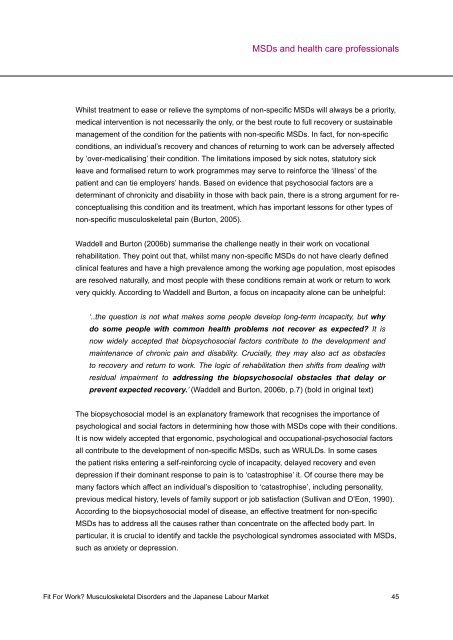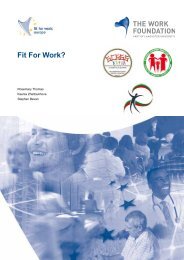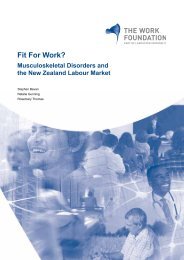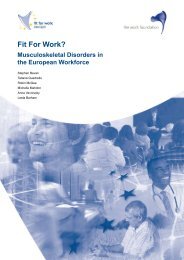English version - Fit for Work Europe
English version - Fit for Work Europe
English version - Fit for Work Europe
You also want an ePaper? Increase the reach of your titles
YUMPU automatically turns print PDFs into web optimized ePapers that Google loves.
MSDs and health care professionals<br />
Whilst treatment to ease or relieve the symptoms of non-specific MSDs will always be a priority,<br />
medical intervention is not necessarily the only, or the best route to full recovery or sustainable<br />
management of the condition <strong>for</strong> the patients with non-specific MSDs. In fact, <strong>for</strong> non-specific<br />
conditions, an individual’s recovery and chances of returning to work can be adversely affected<br />
by ‘over-medicalising’ their condition. The limitations imposed by sick notes, statutory sick<br />
leave and <strong>for</strong>malised return to work programmes may serve to rein<strong>for</strong>ce the ‘illness’ of the<br />
patient and can tie employers’ hands. Based on evidence that psychosocial factors are a<br />
determinant of chronicity and disability in those with back pain, there is a strong argument <strong>for</strong> reconceptualising<br />
this condition and its treatment, which has important lessons <strong>for</strong> other types of<br />
non-specific musculoskeletal pain (Burton, 2005).<br />
Waddell and Burton (2006b) summarise the challenge neatly in their work on vocational<br />
rehabilitation. They point out that, whilst many non-specific MSDs do not have clearly defined<br />
clinical features and have a high prevalence among the working age population, most episodes<br />
are resolved naturally, and most people with these conditions remain at work or return to work<br />
very quickly. According to Waddell and Burton, a focus on incapacity alone can be unhelpful:<br />
‘..the question is not what makes some people develop long-term incapacity, but why<br />
do some people with common health problems not recover as expected? It is<br />
now widely accepted that biopsychosocial factors contribute to the development and<br />
maintenance of chronic pain and disability. Crucially, they may also act as obstacles<br />
to recovery and return to work. The logic of rehabilitation then shifts from dealing with<br />
residual impairment to addressing the biopsychosocial obstacles that delay or<br />
prevent expected recovery.’ (Waddell and Burton, 2006b, p.7) (bold in original text)<br />
The biopsychosocial model is an explanatory framework that recognises the importance of<br />
psychological and social factors in determining how those with MSDs cope with their conditions.<br />
It is now widely accepted that ergonomic, psychological and occupational-psychosocial factors<br />
all contribute to the development of non-specific MSDs, such as WRULDs. In some cases<br />
the patient risks entering a self-rein<strong>for</strong>cing cycle of incapacity, delayed recovery and even<br />
depression if their dominant response to pain is to ‘catastrophise’ it. Of course there may be<br />
many factors which affect an individual’s disposition to ‘catastrophise’, including personality,<br />
previous medical history, levels of family support or job satisfaction (Sullivan and D’Eon, 1990).<br />
According to the biopsychosocial model of disease, an effective treatment <strong>for</strong> non-specific<br />
MSDs has to address all the causes rather than concentrate on the affected body part. In<br />
particular, it is crucial to identify and tackle the psychological syndromes associated with MSDs,<br />
such as anxiety or depression.<br />
<strong>Fit</strong> For <strong>Work</strong>? Musculoskeletal Disorders and the Japanese Labour Market 45







